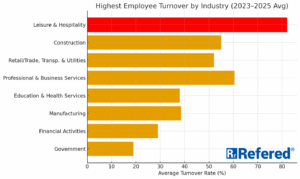Introduction
When it comes to business challenges, the highest employee turnover by industry is one of the most costly and disruptive. Every year, millions of hourly workers leave their jobs, forcing companies to spend valuable time and money finding replacements. According to the Bureau of Labor Statistics, industries like leisure and hospitality, construction, and retail consistently face some of the highest turnover rates, with hourly employees most at risk of leaving.
High turnover doesn’t just drain budgets… it damages morale, slows productivity, and puts customer satisfaction at risk. The good news is that by understanding which industries struggle most with retention, why employees quit, and what strategies work best, businesses can start building a stronger and more loyal workforce.
In this article, we’ll break down employee turnover by industry, highlight the reasons hourly workers are more likely to leave, and share proven tips to reduce turnover, along with how Refered helps businesses keep their best people longer.
What Is Employee Turnover?
Before we dive into the industries with the highest employee turnover by industry, it’s important to define exactly what employee turnover means. At its core, employee turnover is the percentage of workers who leave a company during a set period of time, usually measured annually. This number includes both voluntary quits (employees choosing to leave) and involuntary separations (layoffs, retirements, or terminations).
How to Calculate Employee Turnover
The formula for calculating turnover is straightforward:
(Number of Employees Who Left ÷ Average Number of Employees) × 100
For example, if a company had 20 employees leave in a year and maintained an average headcount of 200, the calculation would look like this:
20 ÷ 200 = 0.10 × 100 = 10% turnover rate
This metric is critical because it helps employers measure how well they’re retaining talent compared to their industry peers.
Why Turnover Rates Matter
Turnover isn’t just a number on a spreadsheet… it’s a direct reflection of employee satisfaction, company culture, and management effectiveness. According to SHRM, replacing an employee can cost between 50% and 200% of their annual salary when you factor in recruiting, onboarding, and lost productivity.
That’s why understanding and tracking your turnover rate is the first step toward reducing it.
Average Employee Turnover Rates by Industry
Now that we’ve defined the basics, let’s look at which sectors consistently show the highest employee turnover by industry. Data from the Bureau of Labor Statistics (BLS) highlights how much turnover varies depending on the work environment, job type, and pay structure. Hourly employees, especially in customer-facing or physically demanding roles, are far more likely to leave than salaried workers.
Turnover Statistics by Industry (2023–2025)
While average turnover across all industries hovers around 40–45%, certain industries face far higher challenges:
-
Leisure & Hospitality: ~79–85% turnover (highest overall, largely hourly jobs)
-
Construction: ~53–57% turnover (skilled trades and seasonal labor)
-
Retail/Trade, Transportation & Utilities: ~49–55% turnover
-
Professional & Business Services: ~57–64% turnover
-
Education & Health Services: ~37–39% turnover
-
Manufacturing: ~37–40% turnover
-
Financial Activities: ~29% turnover
-
Government: ~18–20% turnover (lowest overall)

Key Takeaway
The highest turnover by industry consistently occurs in Leisure & Hospitality, followed closely by Construction and Retail/Trade. These industries rely heavily on hourly employees who often face unpredictable schedules, lower wages, and fewer advancement opportunities—all major drivers of turnover.
Internal Benchmarking
For companies struggling with retention, comparing your numbers to these industry benchmarks is a valuable first step. If your turnover rate is significantly higher than your industry’s average, it’s a clear signal that deeper issues may be at play in your recruitment, management, or employee engagement strategies.
For tips on strengthening recruitment, see our guide on how to revamp an employee referral program.
Why Hourly Employees Quit More Often
Understanding the causes behind the highest employee turnover by industry helps explain why hourly employees are especially vulnerable. Unlike salaried workers who may have more stability and benefits, hourly employees often face a different set of challenges that make long-term retention difficult.
1. Low Pay and Insufficient Benefits
Compensation remains one of the top reasons employees leave. According to Gallup, more than 60% of workers cite low pay as a primary driver of turnover. Hourly employees in industries like hospitality and retail often earn near minimum wage, with limited or no health benefits, making them more likely to seek better opportunities elsewhere.
2. Lack of Scheduling Flexibility
Hourly jobs often come with unpredictable shifts, mandatory overtime, or inconsistent hours. This makes it difficult for employees to balance personal responsibilities. Nearly half of employees quit due to poor work-life balance, a challenge that disproportionately affects hourly workers.
3. Few Career Advancement Opportunities
Many hourly employees feel stuck in roles without clear pathways to promotions or professional growth. This lack of development leads to disengagement and ultimately higher turnover.
4. Poor Management and Work Culture
Studies show that nearly 50% of employees have left a job to escape a bad manager. Hourly roles often involve high-pressure environments with little recognition, creating a culture where employees don’t feel valued or supported.
5. High Stress and Burnout
From fast-paced restaurants to physically demanding construction jobs, hourly positions are often intense and exhausting. Without proper recognition or support, burnout sets in quickly, fueling high turnover.
The Real Cost of High Turnover
When looking at the highest employee turnover by industry, it’s easy to focus on the percentages—but the true impact is measured in dollars and long-term stability. High turnover comes with hidden and visible costs that can quickly drain resources.
Direct Costs of Turnover
-
Recruiting & Advertising: Posting jobs, using job boards, and running ads to attract applicants.
-
Onboarding & Training: Every new employee requires orientation, paperwork, and time to get up to speed.
-
Lost Productivity: New hires take months to reach full efficiency, which slows down teams.
Indirect Costs of Turnover
-
Declining Morale: When coworkers leave, remaining employees start questioning their own future.
-
Increased Stress: Fewer people on the job means more work for everyone else, leading to burnout.
-
Customer Experience Issues: Turnover disrupts service quality, which can drive customers away.
The Ripple Effect
High turnover often creates a cycle: as more employees leave, others wonder why? That curiosity can lead them to explore opportunities elsewhere, creating a snowball effect that makes retention even harder.
Strategies to Reduce Turnover in High-Risk Industries
Even in sectors with the highest employee turnover by industry, businesses can take meaningful steps to reduce churn. By focusing on people-first practices and modern retention tools, employers can turn a high-risk environment into a place where employees want to stay.
1. Create a Strong Onboarding Experience
First impressions matter. Employees who have a structured, positive onboarding experience are 69% more likely to stay at least three years. Clear communication, role expectations, and early recognition set the stage for long-term retention.
2. Improve Scheduling Flexibility
For hourly employees, schedule flexibility is often more valuable than perks. Offering predictable shifts, time-off options, or flexible start/end times reduces stress and builds loyalty.
3. Offer Career Growth Opportunities
Investing in training, mentorship, and advancement paths gives employees a reason to stay. According to Gallup, 88% of employees value professional development opportunities when choosing a workplace.
4. Provide Competitive Pay and Benefits
Compensation isn’t everything, but it matters. Companies in hospitality, retail, and construction that adjust pay scales and offer better benefits see turnover drop significantly.
5. Recognize and Reward Employees
Recognition programs lower voluntary turnover by 31%. Even small gestures (peer-to-peer shoutouts, milestone celebrations, or performance-based rewards) can make employees feel valued.
6. Build an Inclusive and Supportive Culture
Toxic workplaces drive people away. Companies that prioritize inclusivity, trust, and respect see stronger employee engagement and reduced turnover.
How Refered Helps Reduce Turnover
Tackling the highest employee turnover by industry requires more than good intentions—it requires the right tools. That’s where Refered comes in. Our platform is built to help industries like construction, hospitality, and home services reduce turnover by making it easier to recruit, engage, and retain the right people.
1. Employee Referral Automation
Your best employees know other great employees. Refered automates referral programs, making it simple for teams to recommend trusted candidates. This not only fills roles faster but also improves retention… referrals typically stay longer than job-board hires.
2. All-in-One ATS + Job Board Syndication
Posting jobs across multiple boards takes time. Refered’s integrated ATS publishes openings everywhere with a single click, then tracks applicants from start to finish. That means fewer delays and faster hires, reducing the costly gaps that high turnover creates.
3. AI-Generated Job Posts
Finding hourly workers requires speed. Our AI assistant creates compelling job descriptions instantly, ensuring your openings stand out to candidates in competitive industries.
4. Seamless Payroll Integration with Paychex
Turnover often spikes when referral bonuses or recognition programs aren’t managed consistently. With our Paychex integration, rewards are automated and on time, building trust with your workforce.
5. Retention Analytics
Refered’s dashboards help you monitor referral performance, track hiring trends, and identify risks early. With real-time data, you can make smarter staffing decisions to prevent turnover before it happens.
By combining employee referrals, automation, and retention insights, Refered helps businesses keep their best workers and spend less time scrambling to replace them.
Conclusion
The data is clear: industries like Leisure & Hospitality, Construction, and Retail consistently face the highest employee turnover by industry. For employers, this reality creates serious financial and cultural challenges… but it’s not a problem without solutions. By improving onboarding, offering flexibility, recognizing employees, and building inclusive workplaces, businesses can slow the revolving door.
Most importantly, using the right tools makes a measurable difference. Refered gives companies the power to hire faster, reward employees consistently, and build a culture of trust, all while reducing turnover costs.
👉 Ready to lower turnover and keep your best employees? See how Refered can help.





